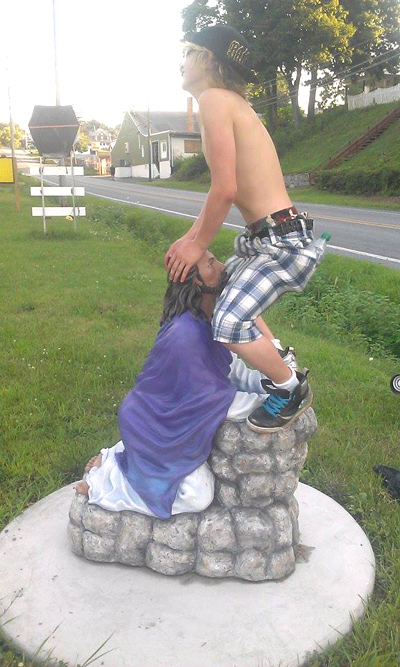Almost a year ago, College Humor ran a short piece that was basically just photos of people pretending to fellate Ronald McDonald. (This is a classic prank, incidentally, one that I first saw posted on USENET back in the 1990’s under the name of “free fries.”) No one gets upset with this sort of foolishness, no one gets charged with a crime. It’s just kids being kids.
More recently, a Pennsylvania teenager thought it would be a laugh to pretend that a similarly well-known statue (from a different globe-spanning franchise) was fellating him:
I can think of a couple significant differences between the McDonald’s pranks and this one, most notably that this one is homoerotic and involves a figure thought by many to be sacred. There is also the fact that churches are not treated as places of public accommodation, whereas restaurants are, although that probably won’t come into play here since the church has not elected to sue this kid for trespassing, or to press charges in any way.
This isn’t to say that no legal proceedings will transpire, because the State of Pennsylvania recognizes the crime of desecration as a second degree misdemeanor. There is a quick explainer over at Findlaw on the legal aspects of the case, but what it comes down to is that Pennsylvanians can be punished criminally for “physically mistreating” a venerated object “in a way that the actor knows will outrage the sensibilities of persons likely to observe or discover the action.”
Had the statue been vandalized or damaged, as in a previous Pennsylvania case, then of course the perpetrator should be required to make the owners whole. However, it is utterly ridiculous that we have laws designed to allow people to physically punish others, using the force of the state, on account of nothing more than outraged sensibilities. Having spent too much time on Tumblr, I find it horrifying that performances of public outrage might in some rare cases have serious penal consequences.
Perhaps, though, I’m being too lenient because I have trouble relating to the idea of sacred objects. If you were the judge in this case, and you were given wide leeway to decide on an appropriate punishment, how would you rule?

